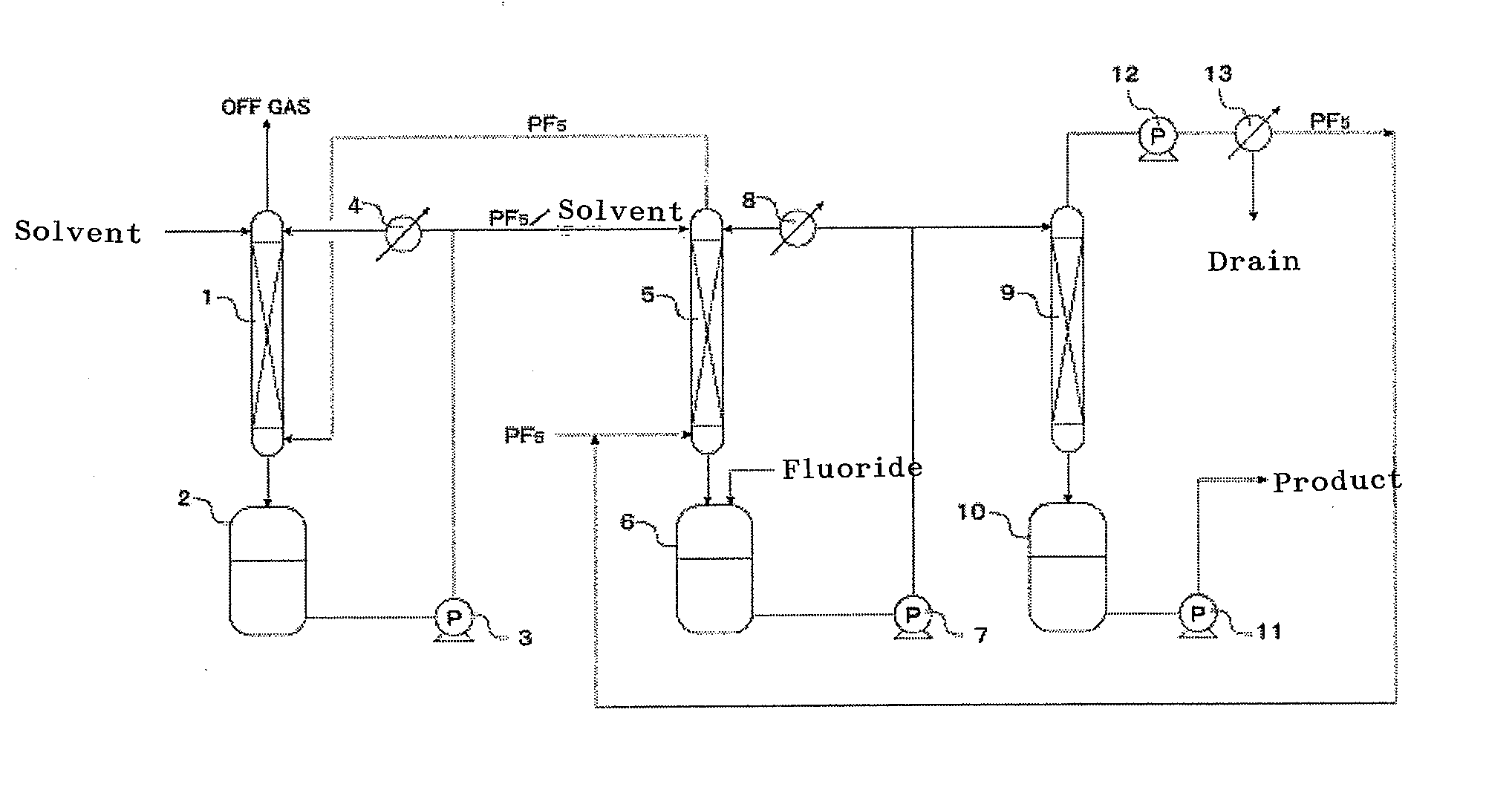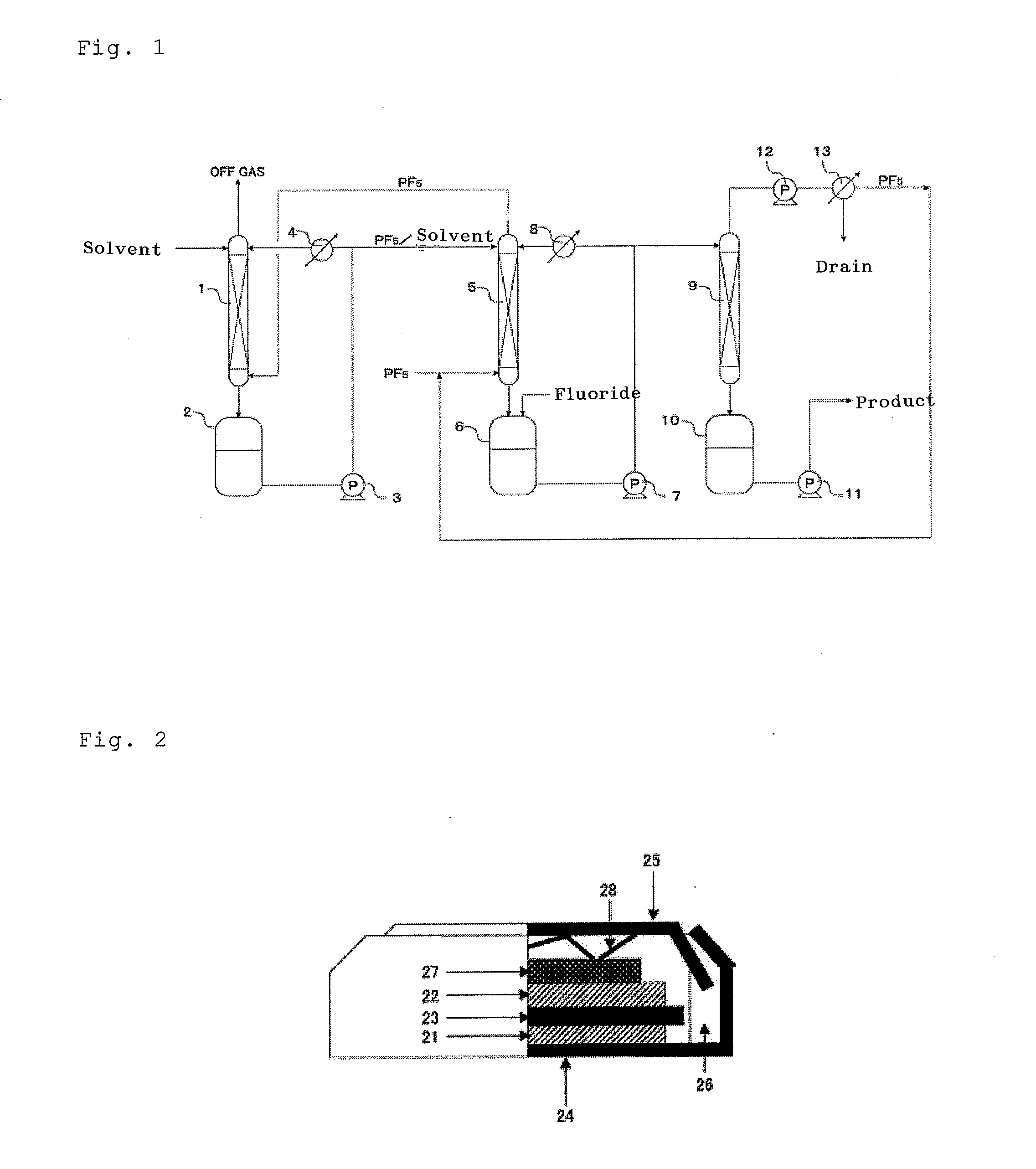Process for production hexafluorophosphates
a technology of hexafluorophosphate and manufacturing method, which is applied in the direction of phosphorus halide/oxyhalide, secondary cell details, electrochemical generators, etc., can solve the problems of poor handling properties, high cost of pfsub>5/sub> used in the manufacture of a high-quality hexafluorophosphate that can be used as an electrolyte of a lithium ion secondary battery or the like, and achieve high safety a hexafluorophosphate, a hexafluorophosphate and a hexafluorophosphate and a hexafluorophosphate and a hexafluorophosphate and hexafluorophosphate and hexafluorophosphate and hexafluorophosphate and hexafluorophosphate technology, applied in the field of hexafluorophosphate technology, hexafluorophosphate technology, hexafluorophosphate hexafluorophosphate hexafluorophosphate hexafluorophospha
- Summary
- Abstract
- Description
- Claims
- Application Information
AI Technical Summary
Benefits of technology
Problems solved by technology
Method used
Image
Examples
example 1
[0072]In a 5 L reaction vessel made of a fluororesin, 1,000 g of ultrapure water was poured and the reaction vessel was heated in an oil bath, and then ultrapure water was maintained at 40° C. While stirring this ultrapure water by a rotator, 800 g of commercially available acidic ammonium fluoride (NH4F.(HF)) was added little by little and then dissolved.
[0073]While maintaining the temperature of the solution in the reaction vessel at 40° C., 740 g of a POF3 gas was made to be absorbed in the reaction solution by bubbling. The absorption amount was determined by an increase in the weight of the reaction solution. After making the POF3 gas to be absorbed, the temperature of the reaction solution was adjusted to 20° C. while stirring for 2 hours and then the liquid temperature was maintained at a same temperature.
[0074]Next, the reaction vessel was heated again in the oil bath and the solution in the reaction vessel was evaporated to dryness. The crystal remaining in the reaction ves...
example 2
[0076]In a 3 L reaction vessel made of a fluororesin (PFA), 100 g of acidic potassium fluoride (KF.(HF)) and 500 g of a 75 wt % hydrogen fluoride (HF) solution of a semiconductor grade were placed, together with a rotator, and then KF(HF) was dissolved while stirring in an ice bath. After weighing 140 g of a 85 wt % phosphoric acid (H3PO4) solution in a separatory funnel, the solution was slowly added dropwise under an ice bath over 30 minutes and the reaction was performed for 6 hours while stirring.
[0077]Next, this solution was crystallized by cooling at −5° C. for 24 hours, thus obtaining a hydrogen fluoride solution containing a precipitate. This hydrogen fluoride solution was filtered by suction filtration. The liquid temperature of the hydrogen fluoride solution was −5° C. The concentration of HF of the filtrate was determined and found to be 46% by weight.
[0078]The collected crystal was rinsed with 600 g of a 75 wt % hydrogen fluoride (HF) solution of a semiconductor grade. T...
example 3
[0082]In a 3 L reaction vessel made of PFA, 210 g of cesium fluoride (CsF) and 700 g of a 75 wt % hydrogen fluoride (HF) solution of a semiconductor grade were placed, together with a reactor, and then CsF was dissolved under an ice bath while stirring. After weighing 175 g of a 85 wt % phosphoric acid (H3PO4) solution in a separatory funnel, the solution was slowly added dropwise under an ice bath over 30 minutes and the reaction was performed for 12 hours while stirring.
[0083]Next, this solution was crystallized by cooling at −5° C. for 36 hours, thus obtaining a solution containing a precipitate. This solution was filtered by suction filtration. The liquid temperature of the phosphoric acid solution was −5° C. The concentration of HF of the filtrate was determined and found to be 55% by weight.
[0084]The collected crystal was rinsed with 400 g of anhydrous hydrogen fluoride acid cooled to 0° C. Subsequently, the filtrate after rinsing was transferred to a 3 L bottle made of a fluo...
PUM
| Property | Measurement | Unit |
|---|---|---|
| temperature | aaaaa | aaaaa |
| boiling point | aaaaa | aaaaa |
| temperature | aaaaa | aaaaa |
Abstract
Description
Claims
Application Information
 Login to View More
Login to View More - R&D
- Intellectual Property
- Life Sciences
- Materials
- Tech Scout
- Unparalleled Data Quality
- Higher Quality Content
- 60% Fewer Hallucinations
Browse by: Latest US Patents, China's latest patents, Technical Efficacy Thesaurus, Application Domain, Technology Topic, Popular Technical Reports.
© 2025 PatSnap. All rights reserved.Legal|Privacy policy|Modern Slavery Act Transparency Statement|Sitemap|About US| Contact US: help@patsnap.com


